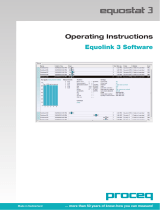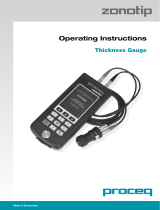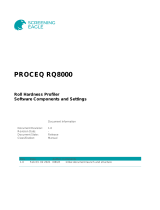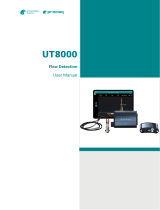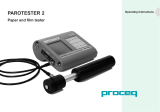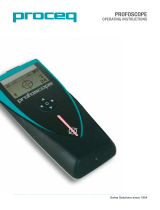Page is loading ...

Swiss Solutions since 1954
Design Patent Pending
®
Operating Instructions

© 2017 Proceq SA 2
Contents
1. Safety and Liability ..................................................... 3
1.1 General Information ........................................................... 3
1.2 Liability ...............................................................................3
1.3 Safety Instructions ............................................................3
1.4 Correct Usage ...................................................................3
2. Technical Specifications .............................................. 4
3. Operation ...................................................................... 6
3.1 Getting Started ..................................................................6
3.2 Main Menu .........................................................................8
3.3 Pundit 200 .......................................................................... 8
3.4 Pundit 200 Pulse Echo ....................................................22
3.5 Pundit 250 Array ..............................................................31
4. Explorer Document Handling ..................................... 42
5. Ordering Information ................................................. 43
5.1 Units .................................................................................43
5.2 Transducers .....................................................................44
5.3 Pundit Array Transducer Parts and Accessories ...........44
5.5 Accessories .....................................................................44
6. Maintenance and Support ......................................... 45
6.1 Maintenance ....................................................................45
6.2 Support Concept .............................................................45
6.3 Warranty Information .......................................................45
6.4 Disposal ...........................................................................45
7. PL-Link Software ....................................................... 45
7.1 Starting PL-Link ............................................................... 45
7.2 Viewing the Data ............................................................46
7.3 Adjusting the Settings .....................................................48
7.4 Analysis of B-scans ......................................................... 48
7.5 Exporting Data ................................................................. 49
7.6 Further Functions ............................................................49
7.7 Conversion Curves ..........................................................50
7.8 E-modulus Calculator .....................................................50

3 © 2017 Proceq SA
1. Safety and Liability
1.1 General Information
This manual contains important information on the safety, use and main-
tenance of the Pundit Touchscreen. Read through the manual carefully
before the first use of the instrument. Keep the manual in a safe place for
future reference.
1.2 Liability
Our “General Terms and Conditions of Sales and Delivery” apply in all
cases. Warranty and liability claims arising from personal injury and dam-
age to property cannot be upheld if they are due to one or more of the
following causes:
• Failure to use the instrument in accordance with its designated use as
described in this manual.
• Incorrect performance check for operation and maintenance of the in-
strument and its components.
• Failure to adhere to the sections of the manual dealing with the per-
formance check, operation and maintenance of the instrument and its
components.
• Unauthorised modifications to the instrument and its components.
• Serious damage resulting from the effects of foreign bodies, accidents,
vandalism and force majeure.
All information contained in this documentation is presented in good faith
and believed to be correct. Proceq SA makes no warranties and excludes
all liability as to the completeness and/or accuracy of the information.
1.3 Safety Instructions
The equipment is not allowed to be operated by children or anyone under
the influence of alcohol, drugs or pharmaceutical preparations. Anyone
who is not familiar with this manual must be supervised when using the
equipment.
• Carry out the stipulated maintenance properly and at the correct time.
• Following completion of the maintenance tasks, perform a functional
check.
1.4 Correct Usage
• The instrument is only to be used for its designated purpose as de-
scribe herein.
• Replace faulty components only with original replacement parts from
Proceq.
• Accessories should only be installed or connected to the instrument
if they are expressly authorized by Proceq. If other accessories are
installed or connected to the instrument then Proceq will accept no
liability and the product guarantee is forfeit.
The following statement applies to the products covered in this manual,
unless otherwise specified herein. The statement for other products will
appear in the accompanying documentation.

© 2017 Proceq SA 4
NOTE! This equipment has been tested and found to comply
with the limits for a Class B digital device, pursuant to Part 15
of the FCC Rules and meets all requirements of the Canadian
Interference-Causing Equipment Standard ICES-003 for digi-
tal apparatus. These limits are designed to provide reasonable
protection against harmful interference in a residential instal-
lation. This equipment generates, uses, and can radiate radio
frequency energy and, if not installed and used in accordance
with the instructions, may cause harmful interference to radio
communications. However, there is no guarantee that interfer-
ence will not occur in a particular installation. If this equipment
does cause harmful interference to radio or television recep-
tion, which can be determined by turning the equipment off
and on, the user is encouraged to try to correct the interfer-
ence by one or more of the following measures:
• Reorient or relocate the receiving antenna
• Increase the separation between the equipment and receiver
• Connect the equipment into an outlet on a circuit different
from that to which the receiver is connected
• Consult the dealer or an experienced radio/T.V. technician
for help
This device complies with part 15 of the FCC:
Operation is subject to the following two conditions: (1) This device may not
cause harmful interference, and (2) this device must accept any interference
received, including interference that may cause undesired operation.”
This Class B digital apparatus complies with Canadian ICES-0003.
2. Technical Specifications
Pundit Touchscreen
Display 7” colour display 800x480 pixels
Memory Internal 8 GB flash memory
Regional settings Metric and imperial units and multi-lan-
guage and timezone supported
Power input 12 V +/-25 % / 1.5 A
Battery 3.6 V, 14 Ah
Battery lifetime > 8h (in standard operating mode)
Humidity < 95 % RH, non condensing
Operating temperature -10°C to +50°C
IP classification IP54
Dimensions 250 x 162 x 62 mm
Weight ~ 1.5 kg (incl. battery)
Standards and Directives CE certification
Pollution Degree 2
Installation Category 2

5 © 2017 Proceq SA
Power Supply
Model HK-AH-120A500-DH
Input 100-240 V / 1.6 A / 50/60 Hz
Output 12 V DC / 5 A
Max. Altitude 2’500 m above sea level
Humidity < 95%
Operating Temperature 0°C - 40°C
Environment Indoor use only
Pollution Degree 2
Installation Category 2
Pundit 200 and Pundit 200 Pulse Echo
Range 0.1 – 7930 μs
Resolution 0.1 μs (< 793 μs), 1 μs (> 793 μs)
Display 7” colour display 800x480 pixels
Pulse Voltage UPV 100 Vpp – 450 Vpp
Pulse Voltage UPE 100 Vpp - 400 Vpp
Receiver Gain 1x – 10’000x (0 – 80dB) [11 steps]
Receiver Sensitivity 10 μV
Receiver Input Impedance 7 kΩ
Pulse Echo Range 0.1 – 1200 μs
Transducer Frequency 50 kHz
Aperture Size 2x25 cm2
Bandwidth 20 – 500 kHz
Pundit 250 Array
Receiver
Gain 0 – 80 dB
Analog Bandwidth 15 kHz – 100 kHz
Nominal transducer
frequency
50 kHz shear wave
Range 0 – 1000μs
Resolution 1 μs
Transmitter
Pulse Voltage +/-150 V
Pulse Shape rectangle
Pulse Delay 8 ms – 200 ms
Power Supply
Batteries 6 x NiMH, Size AA, 2300 mAh (can be
replaced by the user)
Battery lifetime > 7 h
Mains 12 V – 15 V
Operating Time min. 7 h
Charging Time approx. 150 min

© 2017 Proceq SA 6
Aperture
Number of Channels 8 (with upgrade option to 16)
Transducers per Channel 3
Wave Type shear wave, horizontally polarized
Center Frequency approx. 45 kHz
Transducer Bandwidth 80 % – 100 %
Channel distance 3 cm
Aperture Size 21 cm x 5 cm
Miscellaneous
Weight ~ 3 kg
Operating Temperature -10° – 50°
Humidity < 95 % RH, non condensing
Dimensions 240 x 273 x 153 mm
Laser used for positioning support
Camera 240 x 320 Pixel
3. Operation
The information provided in this manual covers all applications supported
by the Pundit Touchscreen.
3.1 Getting Started
Battery Installation Pundit Touchscreen
To install the Battery into the Pundit Touch-
screen Unit, lift the stand as shown. Insert the
battery and fasten in place with the screw.
There are two status LEDs 1 (see page 11) and above them a light
sensor. The upper LED is red while charging and turns to green when it is
fully charged. The other LED is application specific.
NOTE! Only use the power supply provided.
• A complete charge requires approx. 9h (Instrument not operating).
• Charging time is much longer if the instrument is in use.
• An optional quick charger (Part No. 327 01 053) can be used to charge
a spare battery or to charge the battery outside of the instrument. In
this case it takes approx. 4h for a complete charge.

7 © 2017 Proceq SA
Energy Saving
Energy saving may be programmed as desired under System/Power set-
tings.
Connecting the Transducers
(G)
Connect the Transducers to the Pundit Touch-
screen Unit using the BNC Adapter Cable
and the BNC Cables. Ensure that the screws
are fastened on the BNC adapter cable.
USB Host:
Connect a mouse, keyboard or USB stick.
USB Host
USB Device
Ethernet
Power Supply
USB Device:
Connect to a PC.
Ethernet:
Connection for firmware upgrades.
Power Supply:
Connect the power supply through this connection.
Buttons
Lift the protective visor.
At the upper right of the screen there are three buttons 2 (see page 11).
Power On/Off – Press to power on. Press and hold to power off.
Soft Key – Open a pdf document (e.g. Operating instructions) or
toggle full screen view.
Back Button – returns to previous screen.
Battery Installation Pundit Array Transducer
Remove the battery pack from the Pundit Array Transducer by loosening
the two screws and pulling out the battery pack. On the underside there
is a plate which has to be removed by unscrewing two screws to access
the battery compartment.
NOTE! Insert the six AA NiMH rechargeable batteries into the
battery pack being sure to observe the correct polarity and
replace into the Pundit Array Transducer. Before first use, ful-
ly charge the batteries using the charger provided. While the
battery is charging the status LED is green. It will extinguish
when fully charged. A full charge takes about 2.5 hours.
By pressing and holding the fuel gauge button, the actual
charge statues can be seen. Each LED represents 20%
charge, so all 5 LEDs lit indicates a charge of more than 80%.

© 2017 Proceq SA 8
Any AA batteries may be used with the instrument, but the fuel gauge is
only accurate when the recommended NiMH batteries are used.
WARNING!
If standard alkaline batteries (non-rechargeable) are used, it is
very important not to connect the charger as this will result in
damage to the instrument.
3.2 Main Menu
On start up the main menu containing 6 icons is displayed.
Measurement: Application specific measurement screen.
Settings: For application specific settings.
Explorer: File manager functionality for reviewing mea-
surements saved on the instrument.
System: For system settings, e.g. language, display op-
tions, power settings.
Information: For device information and operating instruc-
tions.
Exit: Power Off.
All functions may be accessed directly via the touch screen. Return to the
previous menu by pressing the back button or the return icon (arrow) at
the top left of the touch screen.
3.3 Pundit 200
Scroll up and down the screen by dragging your finger up or down the
screen. The current setting is displayed on the right hand side. Tap on an
item to adjust it.
Transducer
Connected transducer
Select the frequency of the transducer to be used. The custom trans-
ducer setting allows non-standard transducers up to 500 kHz to be used.
If this option is selected, the transducer frequency must also be entered.
NOTE! When a transducer frequency is selected, the factory
settings are automatically loaded for that transducer, based
on 1.5m cables being used. Generally, the accuracy this pro-
vides is sufficient for most applications, so zeroing is not re-
quired with this configuration.
Zeroing Transducer
For increased accuracy or when working with different cable lengths, the
Pundit 200 should be zeroed.
Enter the expected calibration value as it is
marked on the Calibration Rod.

9 © 2017 Proceq SA
Couple the transducers to the Calibra-
tion Rod using the ultrasound Couplant
and press firmly together.
Tap on the start icon to carry out the zeroing.
On completion “Zeroing succeeded” will be displayed.
Tap to return to the settings menu.
Tap to return to the zeroing start screen.
Tap to reload the factory calibration values for the
transducer. This setting provides sufficient accuracy for
most measurements, but for exact zeroing, perform the
procedure described above.
Measurement Settings
Measurement Range
Short range (default). For measurements up to approximately 800 μs.
This corresponds to a path length of approximately 3 m for normal con-
crete. This provides the maximum measurement resolution of 0.1 μs.
For larger objects select the long range. In this case the measurement
resolution is 1 μs.
The measurement screen indicates (--- μs) if a measurement is out of
range.
Pulse Repetition Frequency
Pulse Repetition Frequencies (PRF) of 5 Hz to 40 Hz (measurements per
second) may be selected. High values should be selected only when the
instrument is used on large objects with high receiver amplification set-
tings. In such cases, it helps to increase the update rate on the display.
For general concrete or ceramic materials testing a PRF of between 10-
30 Hz is normally used.
The transducers supplied with the instrument are not damped and, there-
fore, on being excited by the transmitter they have a long ring-down time.
The ring-down time may exceed the pulse interval when the PRF is set
to high values, i. e. the previous pulse may still be ringing as the next
pulse arrives. This effect may cause errors when testing short path length
specimens having low internal damping. If this occurs reduce the PRF.
Line Scan
Line Scan provides the capability to measure along a linear grid at equal
spacing. The distance between the transducers may be varied for each
measurement to accommodate irregular shaped objects (see “3.4.2
Measurement Modes” – Line Scan).
Series Length
Set the number of measurements to be made or leave it open ended.
Distance between Measurements
Set the spacing.
Unit
Choose between pulse velocity or transmission time as the unit for the
graphical display of the results.

© 2017 Proceq SA 10
Units
Unit
Choose between metric and imperial units.
Amplitude Unit
Choose to display the receive signal amplitude either as a percentage or
in decibels.
Compressive Strength Unit
Choose the unit for compressive strength correlations.
E-modulus Unit
Choose the unit for E-modulus calculations.
E-modulus Density Unit
Choose the unit for entering density for E-modulus calculations.
Trigger
Amplitude Trigger
When selected, allows a user defined amplitude threshold for triggering.
Drag the horizontal cursor to the desired trigger level. The zoom function
is useful to set a specific trigger threshold.
Follow Trigger
When selected, the point at which the trigger occurs is always displayed
in the centre of the screen, irrespective of the measured transmission
time. This does not apply if manual triggering or dual cursor triggering is
being used (see “3.3.1 Measurement Screen”).
NOTE! Both triggering options can be selected at the same
time. If none are selected then the triggering is carried out
automatically as normal.
Corrections
Temperature correction UPV
Pulse velocity measurements are affected by several factors. Two key
factors are the moisture content of the concrete and the temperature.
The table below shows the correction factor that should be entered
based on the recommendations made in BS 1881: Part 203.
Temperature Dry concrete Wet concrete
10 °C – 30 °C 1.0 (No correction) 1.0 (No correction)
60 °C 1.05 1.04
40 °C 1.02 1.02
0 °C 0.99 0.99
-4 °C 0.98 0.92
The correction factor is applied to pulse velocity calculations. The meas-
ured transmission time is unaffected.
Amplitude Analysis
Marker
When selected a marker is activated that can be used to record the am-
plitude of the received signal (see”3.3.5 Measuring with Pundit 200”).

11 © 2017 Proceq SA
Area Scan
Raster X: set the grid spacing for the X-axis.
Raster Y: set the grid spacing for the Y-axis.
Measurement count X: Set the number of measurements to be made
in the X-direction.
Measurement count Y: Set the number of measurements to be made in
the Y-direction.
Colour Scheme: Select the colour scheme (can be adjusted later in the
explorer).
Result: Select the measurement parameter you wish to display.
Auto Color Range: On or off. If not selected then the user may define
minimum and maximum settings for the colour range and these may also
be adjusted later in the explorer. The color scheme may also be inverted
by setting the maximum value lower than the minimum.
Data Logging Mode
Interval: Select the interval between measurements. (Minimum interval
is 1 minute).
Number of events: Until the test is completed. (Maximum number of
events is 3000).
Averaging: Determines the number of readings to be taken and aver-
aged at each interval measurement.
Result: select transmission time or pulse velocity.
Distance between transducers: This must be set if pulse velocity is
selected as the test result unit.
3.3.1 Measurement Screen
The standard measurement screen is shown. All settings are directly ac-
cessible from the measurement screen.
Zoom
Zoom in by placing thumb and index finger together on the
screen and spreading them apart. This can be used in both the
horizontal and vertical directions when making a measurement.
Zoom out by placing thumb and index finger apart on the
screen and pinching them together.
Pan
Pan the image from left to right by dragging.
1
123
4
5
6
7
8
9
10
11
2

© 2017 Proceq SA 12
Measuring screen controls
1 Filename: Enter the file name and press return. Saved measure-
ments will be stored with this file name. If several measurements are
made under the same file name, a suffix increments after each measure-
ment.
2 Measurement mode: Select the type of measurement to be carried
out (see section “3.4.2 Measurement Modes”).
3 The top right hand corner of the display shows the current trans-
ducer selected, current time and the battery status.
4 Gain: Adjust the receiver gain, from 1x up to a maximum of 10 000x.
5 Voltage: Adjust the transmitter voltage. For best results, it is best to
begin with low transmitter voltage and a low gain setting. Then increase
until a stable signal level is achieved. Signal clipping should be avoided.
6 Continuous/Burst Transmission:
Continues transmitting until the stop icon is pressed.
Records a measurement as soon as a stable signal is
detected.
7 Settings: Enter the settings menu.
8 Stop/Save:
Stop the current measurement.
Save the current measurement.
Save the current series and continue the measurement.
9 Start/Snapshot:
Begin the measurement.
Save the current measurement as displayed on the
screen and continue measuring.
10 Cursor Selection:
Automatic triggering.
Note: In data logging mode triggering is always
automatic, but may be adjusted manually in PL-Link.
Manual triggering. Set the cursor position manually, by
dragging it to the left or right. The trigger position may also
be adjusted later on the saved waveform in the Explorer.
Dual cursor. Transmission time mode only. Both cursors
have to be set manually. The second cursor is particular-
ly useful when measuring with shear wave transducers.
Dual cursor is selected automatically when measuring in
E-modulus mode.
11 Zoom:
Zoom in and out of the current measurement.

13 © 2017 Proceq SA
3.3.2 Basic Measurement Modes
Transmission Time
The measured transmission time be-
tween the transducers.
Distance
Enter the pulse velocity of the material
under test.
Result is the transmission time and the
distance between the transducers.
Pulse Velocity
Enter the distance between the trans-
ducers.
Result is the transmission time and
the pulse velocity of the material under
test.
Compressive Strength
Prior to carrying out this measurement, a conversion curve valid for the
concrete under test must be created in PL-Link and downloaded to the
instrument.
Select the correlation curve.
Enter the distance between the trans-
ducers.
If a SONREB curve is selected, enter the
rebound value determined at the same lo-
cation as the pulse velocity measurement.
SONREB is a method of combining an ultrasonic pulse velocity measure-
ment with a rebound hammer measurement to improve the accuracy of
compressive strength estimation.
Result is the transmission time and the
compressive strength of the material
under test.
3.3.3 Special Measurement Modes
Crack Depth
The crack depth measurement implemented in Pundit 200 is in accord-
ance with the method described in BS 1881:Part 203.
Enter the distance ‘b’ as indicated in
the diagram shown on the screen.
Position the transducers as shown in ‘Step 1’ on the screen.
Measure t1.

© 2017 Proceq SA 14
Position the transducers as shown in ‘Step 2’ on the screen.
Measure t2.
Result shows the transmission times
t1 and t2 and the crack depth ‘d’.
An incorrect measurement of t1 or t2
may be deleted and repeated before
continuing.
An error message is displayed for an
invalid measurement
(t2 < t1 or t2 > 2 x t1).
NOTE! For this method to give good results, the crack must
be perpendicular to the surface. It must also be free of water
or debris which would allow the wave to propagate through
the crack. The crack must be sufficiently wide to prevent the
wave from simply propagating around it. There must also be no
rebars within the vicinity of the crack. If any of these conditions
occur, the result will be severely affected and it may appear that
the crack depth is much shallower than is actually the case.
Surface Velocity
The surface velocity measurement implemented in Pundit 200 is in ac-
cordance with the method described in BS 1881:Part 203.
The transmitter remains in a fixed position. The receiver is moved at a
fixed interval.
Enter the distance ‘b’ as indicated in the
diagram shown on the screen.
Enter the number of measurements to
be made.
Measure the transmission time at distance ‘b’.
Record the first measurement at distance ‘b’.
Move the receiver a further distance ‘b’ and measure again. Continue
until you have completed the series.
The pulse velocity is calculated from the slope of the curve.
NOTE! If the points recorded show a discontinuity, it is likely
that a surface crack or surface layer of inferior quality is pre-
sent. In this case the measured velocity is unreliable.
E-Modulus
The dynamic E-modulus and the Poisson’s Ratio of a material (e.g. con-
crete or rock) may be determined by measuring the P- and S-wave pulse
velocities. The method is described in the following two standards and is
equally applicable to concrete or other solids:
ASTM D 2845 – Standard Test Method for Laboratory Determination of
Pulse Velocities and Ultrasonic Elastic Constants of Rock.
ISRM – Aydin A., Upgraded ISRM Suggested Method for Determining
Sound Velocity by Ultrasonic Pulse Transmission Technique: Rock Mech
Rock Eng (2014) 47:255-259, DOI: 10.1997/s00603-013-0454-z).

15 © 2017 Proceq SA
Measuring with Dry Point Shear Wave
Transducers
The dual cursor mode is
automatically activated.
Use the first cursor to mark
the onset of the P-wave
component.
Press stop, then press P – S
to switch transducers. Select
the DPC S-wave transducer
40 kHz.
Use the second cursor to
mark the onset of the S-
wave component.
In order to calculate the
E-modulus it is necessary
to enter the density of the
material.
When downloaded to
PL-Link, the Poisson’s
Ratio of the material is also
calculated.
P-waves vs. S-waves
In a P-wave (longitudinal wave) the particle displacement is parallel to
the direction of wave propagation. The particles oscillate back and forth
about their individual equilibrium positions. In an S-wave (shear wave) the
particle displacement is perpendicular to the direction of wave propaga-
tion. The particles oscillate up and down about their individual equilib-
rium positions as the wave passes by.
Measuring with traditional S-wave Transducers
Detection of the shear wave (S-wave) requires the use of the waveform
display in order to manually locate the onset of the shear wave echo as
it is always preceded by a weak P-wave component that is detected by
the automatic triggering.
NOTE! This p-wave component can be used to perform zero-
ing with the shear wave transducers using the recommended
procedure described in chapter 3.3.
S-waves travel in a one-dimensional plane. The strongest signal appears
when the transducers are correctly aligned. This property can be used
to correctly detect the S-wave component of the received signal. When
measurements with the 250 kHz shear wave transducers are performed,
it is crucial to use the special shear wave coupling paste, otherwise shear
waves cannot be properly transmitted into the object under test.
Misaligned by 90°
Weak S-wave component
Weak S-wave
component with
the transducers
misaligned.
Rotate one transducer into and out of alignment and watch the S-wave
component increase and decrease.
Correctly aligned
Strong S-wave component
Much stronger
S-wave component
when the
transducers are
correctly aligned.

© 2017 Proceq SA 16
3.3.4 Multi-Measurement Modes
Line Scan
The distance ‘a’ is entered in the ‘Settings’ menu.
Position the transducers at the start-
ing position and enter the distance x1.
(Not required if transmission time only is
being measured.)
Press the start icon to begin.
Press the snapshot icon and record the first measure-
ment. If burst mode is selected this will be recorded
automatically.
Move the transducers the distance ‘a’ to the next point on the grid.
If the distance ‘x’ does not change press the snapshot icon again to
make the second measurement and so on.
Press this icon to save the current series. If the dis-
tance ‘x’ is different at the new position a new value
may be entered before proceeding with the scan.
Enter the new distance ‘x’.
Press to continue the scan.
Use this icon to delete the last measurement made.
Press the to save the current series and reset the instru-
ment for a new series.
Area Scan
Area scan allows a 2D visualization of an element based on pulse ve-
locity, transmission time or distance measurements. The measurement
grid is defined in ‘Settings.’ If the expected variation of the measured
parameter is not known then select ‘Auto color range.’ This may be sub-
sequently adjusted in the explorer. If the expected range is known, the
color range may be defined by setting a maximum value and a minimum
value. E.g. The Indian standard IS 13311 defines pulse velocity bands for
concrete quality classification.

17 © 2017 Proceq SA
> 4’500 m/s: Excellent
3’500 – 4’500 m/s: Good
3’000 – 3’500 m/s: Medium
< 3’000 m/s: Doubtful
Setting the maximum speed to 4’500 m/s and the minimum speed to
3’000 m/s provides a simple visualization of areas of the structure that
require attention.
The cursor position indicates the position of the next measurement. En-
sure that this aligns with a grid drawn out on the test structure.
You may drag the cursor to the position
on the grid where you wish to start meas-
uring. Arrows indicated the direction of
proceeding with the measurement.
It is possible to drag the cursor to an-
other location on the grid in order to
avoid obstacles etc. It is also possible to
drag the cursor back to previous meas-
urement and either delete it, or measure
it again. In the example below measure-
ment #71 is indicated and may be de-
leted or repeated. If the measurement
is repeated by pressing the snapshot
button, the previous value is overwritten.
The black areas were excluded by drag-
ging the cursor to the next position to be
measured.
Data Logging
The data logging mode allows the user to program a test sequence. A
typical application for this would be to track the pulse velocity change
as concrete sets. The parameters must be set in Settings. Initially the
information box shows the current settings. During the test a countdown
timer indicates the remaining time to the next measurement, the number
of measurements already made and the time at which the test will be
concluded.
The test may be stopped at any time by pressing on the icon.
The information screen may be switched in and out by pressing on the
‘i’ button. The waveforms are saved with each measurement and may
be viewed by tapping on the marker. The trigger points may be adjusted
manually if necessary once the data has been exported to PL-Link.

© 2017 Proceq SA 18
3.3.5 Measuring with Pundit 200
Three transducer arrangements are commonly used.
Direct Transmission: The optimum
configuration with maximum signal
amplitude. The most accurate meth-
od of pulse velocity determination.
Path length is measured from centre
to centre of the transducers.
Indirect Transmission: Signal am-
plitude is approximately 3 % of sig-
nal amplitude when compared to
direct transmission. Path length may
be uncertain. Use the surface veloci-
ty mode to eliminate this uncertainity.
The pulse velocity will be influenced
by the concrete surface zone. Where
possible, carry out a comparison
with a direct transmission measure-
ment to eliminite any uncertainly.
Semi-direct Transmission: Sen-
sitivity is somewhere between the
other two methods. Path length is
measured from centre to centre of
the transducers.
Preparation
Basic preparations are common to each application. The distance (path
length) between the transducers should be measured as accurately as
possible (unless you are measuring in transmission time mode).
It is essential in all ultrasonic pulse tests to use some form of couplant
between the faces of the transducers and the material under test. Failure
to do so will result in a loss of signal due to inadequate acoustic coupling.
The ultrasound couplant provided provides good coupling when used
on concrete or other materials having smooth surfaces. Silicone grease,
medium bearing grease or liquid soap may also be used to good effect.
For rougher surfaces, a thick grease or petroleum jelly is recommended.
In some cases it may be necessary to prepare the surface by smoothing
it. If this is not possible the exponential transducers (Part No. 325 40 170)
should be considered.
For line scans a test grid should be drawn out on the surface.
Amplitude Analysis
Amplitude analysis is a method developed at Tonji University in Shanghai
and is widely used throughout China for comparison testing of concrete
in structures.
In order to record the amplitude the Amplitude Analysis Marker must be
set in the settings menu . When this is set, the amplitude is recorded
along with the transmission time as part of the test result.

19 © 2017 Proceq SA
A reference measurement is made on a section of concrete of known quality.
t0: Reference transmission time
A0: Reference receive level
Subsequent measurements on the structure are compared with these
two values and an inference is made about the concrete quality based
on this.
Six different cases are identified which allow the user to make a state-
ment about the concrete quality.
Good quality – High strength.
High fine aggregate content. Low coarse aggregate content.
High coarse aggregate content. Low fine aggregate content.
Defect on surface. Poor coupling.
Measuring through rebar.
Defects, honeycombing, voids.
3.3.6 Transducer Selection Guideline
Physical Influences on Transducer Selection
The selection of the correct transducer for the application is largely de-
pendent on the aggregate (grain) size and the dimensions of the test
object.

© 2017 Proceq SA 20
Effect of particle size
Inhomogeneities (e. g. aggregate particles, voids) in concrete influence
the propagation of an ultrasound pulse. They will scatter the signal. The
effect is very large if the size of the aggregate is equal to or larger than
the wavelength of the ultrasonic signal. This influence can be significantly
reduced by choosing the pulse frequency, such that the wavelength is at
least twice as large as the aggregate size.
It also follows that it is very difficult to detect an anomaly if it is smaller
than half the wavelength.
For rocks and other fine grained materials such as ceramics and wood,
the grain size is less significant. For such materials, the size of the object
to be tested is the most significant factor.
Best results have been obtained on wood with 54 kHz.
For ceramics, the small sample size and fine grain means that 250 kHz or
500 kHz is most widely used.
Effect of sample size
The pulse velocity is reduced significantly if the lateral di-
mensions (perpendicular to the direction of transmission)
is less than the wavelength.
Higher frequency signals, have a better defined edge and therefore make
it easier to identify the onset of the received pulse. However they are
more influenced by scattering. A 500 kHz signal has a wavelength of
around 7 mm (assuming the speed of sound to be 3500 m/s) and is heav-
ily scattered by the coarse aggregate in concrete, limiting the transmis-
sion to a few decimeters at most. A 24 kHz signal has a wavelength of
around 150 mm and is largely unaffected by scattering. The maximum
transmission range may be several meters.
Transducer Wavelength
The wavelength may be easily calculated:
Wavelength = ultrasonic pulse velocity / frequency
For concrete, the ultrasonic pulse velocity ranges from 3000 m/s (poor
quality) to 5000 m/s (high quality). An average value for ordinary concrete
of 3700 m/s (longitudinal wave) and 2500 m/s (shear wave) have been
used for the computation of the wavelengths, the maximum aggregate
size and the minimum lateral dimension of the test object.
NOTE! For ultrasonic measurements made on rock,
ASTM D2845 recommends a minimum lateral dimen-
sion of 5x the wavelength. It also recommends us-
ing a wavelength at least 3x the average grain size.
e. g. An NX core specimen has a diameter of 54.7 mm
A transducer frequency of 250 kHz or 500 kHz would be rec-
ommended for this size of specimen based on this recom-
mendation, (depending on pulse velocity of the rock types to
be tested). Maximum grain size would be 5 mm or 2.33 mm
respectively.
/
